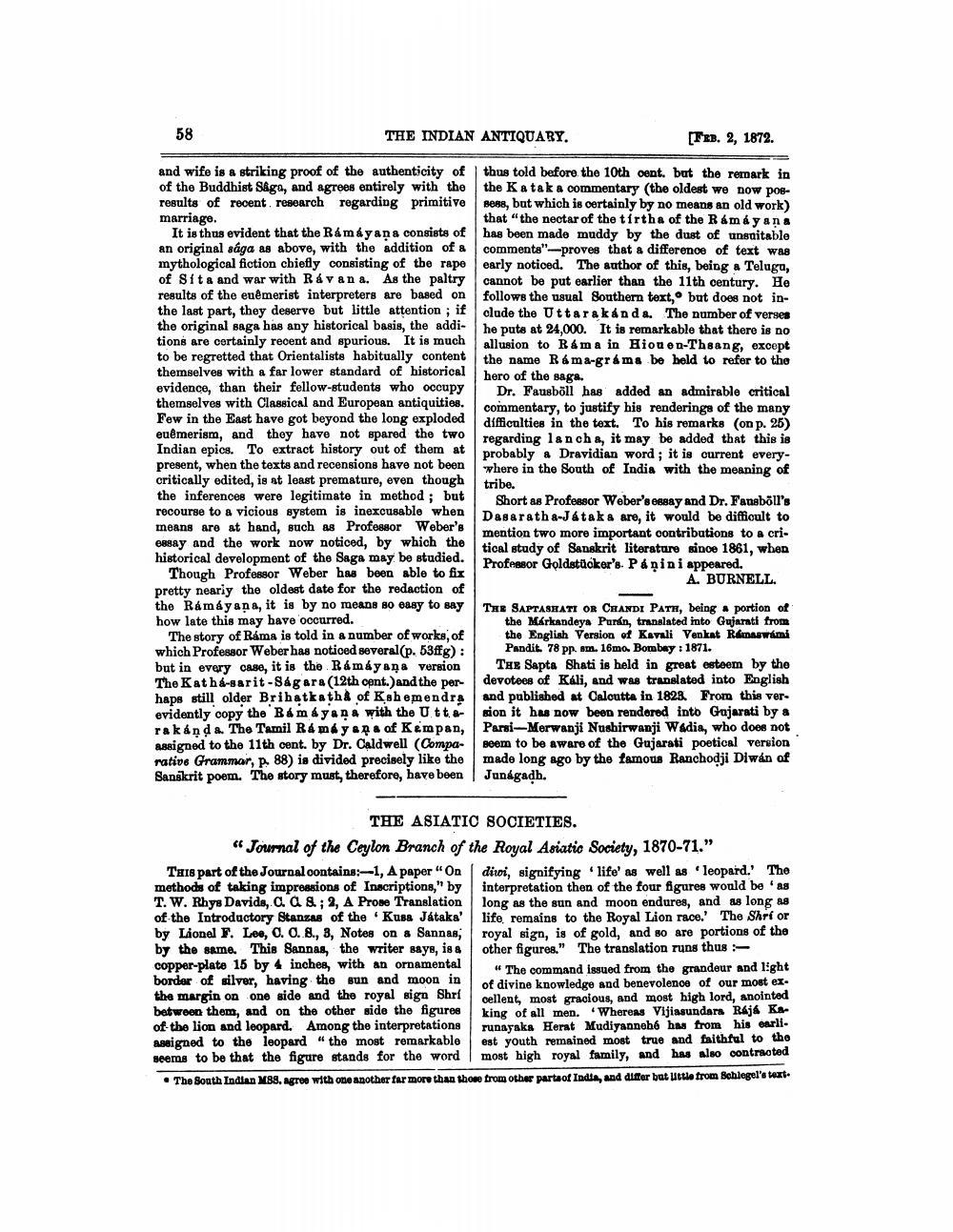________________
THE INDIAN ANTIQUABY.
FEB. 2, 1872.
and wife is a striking proof of the authenticity of of the Buddhist Sága, and agrees entirely with the results of recent research regarding primitive marriage.
It is thus evident that the Rámáyana consists of an original sága as above, with the addition of & mythological fiction chiefly consisting of the rape of Sita and war with Rá vana. As the paltry results of the euệmerist interpreters are based on the last part, they deserve but little attention ; if the original saga has any historical basis, the addi- tions are certainly recent and spurious. It is much to be regretted that Orientalists habitually content themselves with a far lower standard of historical evidence, than their fellow-students who occupy themselves with Classical and European antiquities. Few in the East have got beyond the long exploded euêmerism, and they have not spared the two Indian epics. To extract history out of them at present, when the texts and recensions have not been critically edited, is at least premature, even though the inferences were legitimate in method; but recourse to a vicious system is inexcusable when means are at hand, such as Professor Weber's essay and the work now noticed, by which the historical development of the Saga may be studied.
Though Professor Weber has been able to fix pretty nearly the oldest date for the redaction of the Rámáyana, it is by no means so easy to say how late this may have occurred.
The story of Ráma is told in a number of works of which Professor Weber has noticed several(p. 53ffg): but in every case, it is the Rámáyana version The Kathá-sarit - Ságara (12th cent.) and the perhaps still older Bribatkath& of Kshemendra evidently copy the Bámáyan & with the Utt rakan da. The Tamil Rápayena of Kempan, assigned to the 11th cent. by Dr. Caldwell (Comparative Grammar, p. 88) is divided precisely like the Sanskrit poem. The story must, therefore, have been
thus told before the 10th cent. but the remark in the Kataka commentary (the oldest we now posBERS, but which is certainly by no means an old work) that the nectar of the tirtha of the Ramayana has been made muddy by the dust of unsuitable comments"-proves that a difference of text was early noticed. The author of this, being a Telugu, cannot be put earlier than the 11th century. He follows the usual Southern text, but does not include the Uttarakanda. The number of verses he puts at 24,000. It is remarkable that there is no allusion to Ráma in Hiou en-Theang, except the name Ráma-gráma be held to refer to the hero of the saga.
Dr. Fausböll has added an admirable critical commentary, to justify his renderings of the many difficulties in the text. To his remarks on p. 26) regarding lancha, it may be added that this is probably a Dravidian word; it is current everywhere in the South of India with the meaning of tribe.
Short as Professor Weber's essay and Dr. Fanaböll's Dasarath a-Játaka are, it would be difficult to mention two more important contributions to a critical study of Sanskrit literature since 1861, when Professor Goldstüoker's. Pánini appeared.
A. BURNELL
THE SAPTASHATI OR CHANDI PATH, being portion of
the Markandeya Purán, translated into Gujarati from the English Version of Kavali Venkat Ramaswami Pandit. 78 PP. em. 16mo. Bombay : 1871. The Sapta Shati is held in great esteem by the devotees of Káli, and was translated into English and published at Caloutta in 1828. From this version it has now been rendered into Gajarati by a Parsi-Merwanji Nushirwanji Wadia, who does not seem to be aware of the Gujarati poetical version made long ago by the famous Ranchodji Diwán of Junagadh.
THE ASIATIC SOCIETIES. “ Journal of the Ceylon Branch of the Royal Asiatic Society, 1870-71." This part of the Journal oontains:-1, A paper "On diwi, signifying life' as well as leopard.' The methods of taking impressions of Inscriptions," by interpretation then of the four figures would be as
T. W. Rhys Davide,c. &;2, A Prose Translation long as the sun and moon endures, and as long 88 of the Introductory Stanzas of the 'Kuba Játaka' life, remains to the Royal Lion race.' The Shri or by Lionel F. Lee, O. 0. 8., 8, Notes on a Sannas; royal sign, is of gold, and so are portions of the by the same. This Sannas, the writer saye, is s other figures." The translation runs thus : copper-plate 15 by 4 inches, with an ornamental
" The command issued from the grandeur and light border of silver, having the sun and moon in
of divine knowledge and benevolence of our most ex. the margin on one side and the royal siga Shri
cellent, most gracious, and most high lord, anointed between them, and on the other side the figures
king of all men. "Whereas Vijiasundars Røjá Ksof-the lion and leopard. Among the interpretations runayaka Herat Mudiyannebb ha trom his earli. assigned to the leopard "the most remarkable
est youth remained most true and faithful to the seems to be that the figure stands for the word most high royal family, and has also contracted
• The South Indian M88. agree with one another far more than those trom other parta of India, and differ bat little from Behlegel's out




